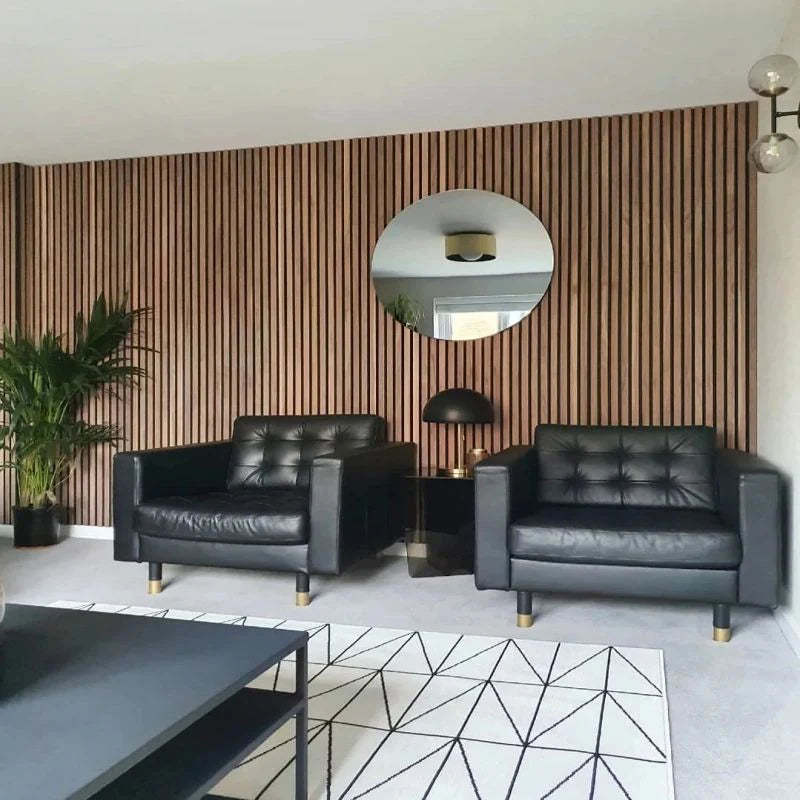(877) 358-5731
Monday-Friday: 10am-6pm EST

How To Use Acoustic Wood Panels For Better Soundproofing
In today's environment, where noise pollution can significantly disrupt peace and focus, identifying effective soundproofing solutions is essential.
Acoustic wood panels present a stylish and functional method for enhancing sound quality in various spaces.
This article examines what acoustic wood panels are, how they function, and the numerous benefits they offer.
It also discusses the most suitable rooms for installation, provides a step-by-step guide for their setup, and shares maintenance tips to ensure optimal appearance and performance.
Readers are invited to explore how these panels can transform their environments.
What Are Acoustic Wood Panels?
Acoustic wood panels are innovative building materials specifically developed to enhance the acoustic properties of interior spaces by effectively managing sound waves and reducing ambient noise. These high-quality panels, typically constructed from materials such as MDF, bamboo, and wood veneer, offer both sound absorption and aesthetic appeal, rendering them suitable for a range of environments, including commercial spaces and hospitality settings.
With their unique designs, such as perforated wood panels and timber slatted panels, they not only improve room acoustics but also enhance modern interiors with their attractive finishes and customizable installation options.
How Do Acoustic Wood Panels Work for Soundproofing?
Acoustic wood panels serve as effective soundproofing solutions by leveraging their sound absorption properties to reduce the impact of sound waves within a room, thereby managing noise levels and enhancing acoustic comfort.
Designed with specific acoustic dynamics, these panels efficiently absorb sound energy and minimize reverberation, making them particularly advantageous in high-traffic environments such as hospitality and commercial spaces.
By strategically positioning these panels and selecting appropriate types, such as micro-perforated or grooved panels, interior design can significantly enhance sound quality, resulting in a more inviting ambiance.
What Are the Benefits of Using Acoustic Wood Panels for Soundproofing?
The benefits of utilizing acoustic wood panels for soundproofing extend beyond the mere enhancement of room acoustics; they offer a range of advantages that render them an essential component of any interior design project focused on improving both functionality and aesthetics.
First and foremost, these high-performance panels significantly enhance sound quality by effectively absorbing unwanted noise and managing sound waves, thereby fostering a more tranquil environment. Additionally, they provide aesthetic appeal through a variety of finishes and designs that can complement any decor style, presenting a cost-effective solution for both residential and commercial spaces.
1. Improved Sound Quality
One of the most significant advantages of acoustic wood panels is their ability to enhance sound quality across various settings through effective sound absorption properties. This capability significantly reduces noise levels and improves overall acoustic comfort.
These innovative panels are specifically designed to absorb unwanted sound waves, minimizing echoes and reverberations that frequently affect both commercial environments, such as offices and restaurants, as well as residential spaces like home theaters and living areas. When strategically placed, acoustic wood panels not only enhance the aesthetic appeal of interior design but also foster a serene atmosphere that allows conversations to flow without distraction.
Their unique construction often incorporates natural materials that enhance both durability and performance, making them a sustainable choice for effective noise reduction. This ensures that every space resonates with clarity and calm.
2. Aesthetically Pleasing
Acoustic wood panels not only serve a functional purpose but also provide significant aesthetic appeal to interior spaces. Available in a wide range of designs, colors, and finishes, these panels can enhance the overall decor of any environment.
These versatile panels can be customized to complement various styles, whether it is the sleek lines of modern design or the warm, rustic feel associated with natural aesthetics. With options that range from rich, dark woods to light, airy tones, they can harmonize beautifully with existing furnishings.
Designers recognize the ability of these panels to transform a simple wall into a statement feature, serving as both an eye-catching focal point and an effective sound-absorbing solution. By incorporating these decorative elements, one can elevate the ambiance of a room, making it feel more inviting and intimate, while maintaining functionality and effectiveness in managing noise.
3. Cost-effective
Plus enhancing sound quality and aesthetics, acoustic wood panels present a cost-effective solution for achieving effective soundproofing, providing high-quality performance without the necessity for extensive construction work.
This innovative approach is notable not only for its affordability but also for its easy installation process, which can be completed in a fraction of the time required by traditional soundproofing methods. Instead of committing to labor-intensive renovations or expensive materials, individuals or businesses seeking to improve their spaces can attain professional results with minimal disruption.
Over time, the accumulated savings render acoustic wood panels a wise choice for those aiming for both immediate and long-term financial benefits, alongside enhanced acoustic comfort and visual appeal in their environments.
What Types of Rooms Can Benefit from Acoustic Wood Panels?
Acoustic wood panels are remarkably versatile and can greatly enhance the acoustic environment in a variety of spaces, rendering them a valuable asset in both residential and commercial applications.
For example, home theaters experience improved sound quality and reduced reverberation, while recording studios benefit from enhanced sound management and clarity in recordings. Furthermore, offices utilize these panels to foster a more productive and comfortable workspace by minimizing noise distractions.
As such, acoustic wood panels have become an essential element in contemporary interior design.
1. Home Theaters
Home theaters significantly benefit from the installation of acoustic wood panels, which enhance sound absorption and effectively reduce ambient noise, thus creating an immersive viewing experience.
These panels adeptly manage sound reflections that can lead to distracting echoes, resulting in clearer dialogue and more precise audio reproduction. By fine-tuning the acoustic properties of the room, users will experience a balanced auditory environment where music, sound effects, and voice clarity are harmoniously integrated.
Moreover, acoustic wood panels provide a stylish aesthetic that complements the decor while fulfilling their functional role. By enhancing the overall audio experience, they contribute to the ideal atmosphere for movie nights, ensuring a setup that is not only acoustically pleasing but also visually appealing.
2. Recording Studios
In recording studios, acoustic wood panels play a crucial role in sound management by optimizing the acoustic properties of the space, ensuring high-quality recordings that are free from unwanted noise interference.
These panels are engineered to absorb and diffuse sound waves effectively, preventing echoes and standing waves that can compromise the clarity of a recording. By strategically placing wood panels throughout the studio, sound professionals can create an optimal environment that enhances vocal clarity and instrumental richness.
The natural characteristics of wood provide warmth and depth to audio, making it an excellent choice for both aesthetic and functional purposes. Ultimately, the inclusion of these acoustic treatments not only elevates the quality of the recordings but also contributes to a more pleasant atmosphere for artists, fostering creativity and expression.
3. Offices
Offices that incorporate acoustic wood panels benefit from enhanced acoustic comfort, as these panels effectively manage noise levels, leading to improved focus and productivity among employees.
By strategically placing these soundproofing solutions throughout an office space, companies can significantly reduce distractions caused by background noises, such as conversations, printer operations, and foot traffic. This results in an environment where employees can concentrate on their tasks more effectively.
Additionally, the aesthetic appeal of acoustic panels contributes to a more inviting workspace, which can enhance employee morale.
With reduced noise interference, collaboration and communication can flow more freely, fostering a sense of teamwork and mutual respect among colleagues. Ultimately, investing in high-quality acoustic solutions not only improves sound quality but also supports the overall well-being of employees.
How to Install Acoustic Wood Panels?
Installing acoustic wood panels is a simple process that can greatly improve both the sound quality and aesthetics of a space when executed properly.
By adhering to a set of installation guidelines and ensuring the correct placement of panels, individuals can achieve optimal sound absorption and acoustic comfort tailored to their specific requirements.
The design flexibility and customization options available for these panels enable adaptation to various interior styles, whether in a modern office setting or a cozy home theater.
1. Determine the Number of Panels Needed
The initial step in installing acoustic wood panels involves accurately determining the number of panels required based on the specific acoustic needs of the room and its dimensions.
To effectively assess these needs, one should begin by measuring the length, width, and height of the space. This data provides a comprehensive understanding of the room's volume, which is crucial for calculating sound absorption requirements. Subsequently, it is essential to consider the room's purpose and typical noise levels; for instance, a music studio will necessitate more treatment than a standard office environment. Evaluating existing surfaces, such as walls and ceilings, will assist in identifying areas that require enhancement.
By integrating these measurements with the acoustic performance ratings of available panel options, it becomes possible to determine the appropriate number of acoustic wood panels needed, thereby ensuring optimal sound quality throughout the space.
2. Choose the Right Location for the Panels
Selecting the optimal locations for acoustic wood panels is essential for maximizing sound absorption and achieving effective acoustic treatment in any environment.
A thorough evaluation of factors such as wall material, furniture arrangement, and the room's natural acoustics can significantly impact the treatment's overall effectiveness. For example, placing panels in areas where sound reflections are most pronounced—such as directly across from hard surfaces—can substantially diminish unwanted echoes. A comprehensive understanding of sound absorption dynamics can aid in determining the most suitable placement.
By carefully analyzing each corner and open space, it is possible to identify areas that would benefit the most from the installation of acoustic panels, thereby ensuring a balanced and harmonious sound environment.
3. Prepare the Surface for Installation
Before installation, it is essential to prepare the surface where the acoustic wood panels will be mounted to ensure proper adhesion and long-lasting performance. This preparation process involves several crucial steps that should not be overlooked.
-
First, thoroughly clean the surface to remove dust, grease, or any contaminants that may hinder adhesion. Utilizing a mild detergent or appropriate cleaning solution can help achieve a pristine state.
-
Next, evaluate the flatness of the surface; any irregularities may impact the installation process and the aesthetic appeal of the panels.
-
It is also vital to assess compatibility with the finishes of the acoustic panels, as certain treatments may not bond effectively with specific materials.
By adhering to these steps, individuals can significantly enhance the overall effectiveness and durability of the installation.
4. Install the Panels
Once the surface is properly prepared, the next step is to install the acoustic wood panels, following a systematic installation process to ensure they are securely mounted and aligned according to the design vision.
The installation should begin with gathering the necessary tools, which typically include a measuring tape, level, chalk line, drill, screws, and adhesive if required. It is essential to measure and mark the locations for each panel, utilizing a level to maintain straight lines and achieve precise alignment.
When attaching the panels, it is advisable to start from a corner to establish a reference point, and to use spacers as needed to maintain uniform gaps. This approach not only enhances the visual appeal but also guarantees consistent spacing throughout the installation process.
It is important to step back frequently to assess progress and make any necessary adjustments to ensure an aesthetically pleasing result.
Tips for Maintaining Acoustic Wood Panels
To ensure the longevity and performance of acoustic wood panels, proper maintenance is essential. This involves regular cleaning and careful consideration of environmental factors that may impact their condition.
Maintaining both the aesthetic appeal and functionality of these panels requires straightforward practices such as regular dusting and minimizing exposure to moisture, which can compromise their acoustic properties.
Furthermore, addressing any damage promptly is crucial for preserving their effectiveness in sound management.
1. Regular Cleaning
Regular cleaning is essential for the maintenance of acoustic wood panels, as the accumulation of dust and debris can compromise their sound absorption effectiveness and overall aesthetic.
For owners of these panels, understanding effective cleaning methods is vital to ensuring optimal performance and maintaining a pristine appearance. It is crucial to utilize gentle materials, such as microfiber cloths or soft brushes, since harsher cleaning tools can damage the delicate wood surfaces.
Establishing a maintenance routine that includes periodic dusting and more thorough cleanings can significantly extend the longevity and functionality of the panels. Furthermore, employing appropriate cleaning solutions specifically formulated for wood will help protect the finish and preserve the aesthetic value of these sound-absorbing installations.
2. Avoiding Moisture Exposure
Avoiding moisture exposure is essential for preserving the durability and effectiveness of acoustic wood panels, as excessive humidity can lead to warping and deterioration. This consideration is crucial not only for the aesthetic appeal of the panels but also for maintaining their sound-absorbing properties.
To mitigate these risks, it is important to monitor the humidity levels in the environment where the panels are installed. Utilizing dehumidifiers in areas prone to moisture can be an effective strategy. Additionally, regularly checking for leaks and ensuring proper ventilation will contribute to maintaining a balanced atmosphere.
Applying protective coatings can enhance the wood’s resilience, significantly extending its lifespan. Implementing these maintenance strategies will ensure that acoustic wood panels perform optimally over time.
3. Repairing Any Damage
Promptly repairing any damage to acoustic wood panels is essential for ensuring their continued effectiveness in sound absorption and acoustic treatment.
Over time, these panels may incur scratches, dents, or moisture damage, which can compromise their functionality. For example, if a panel has warped due to humidity, reinstallation may be required to restore its shape and sound absorption capabilities. Small scratches can typically be addressed with wood filler or paint, while larger dents may necessitate the replacement of the affected panel.
It is crucial to select repair materials that closely match the original finish to preserve the aesthetic appeal of the installation. Regular maintenance checks can aid in the early identification of issues, allowing for proactive repairs that protect the acoustic properties and overall integrity of the panels.

